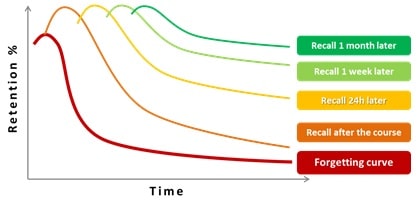by Patricia Santos *
Digital solutions for training are getting smaller in duration. One of the key trends in the eLearning market is micro-learning, which is breaking down the learning content in easily consumable pieces of information of around 5 minutes.
Why should we want to follow this trend? For 2 major reasons.
- Personalized and adaptive learning
- Spaced learning
Just enough, Just in time, Just for me!
People have less and less time for training. They want quick answers to their questions. Most of the elearning solutions propose long and formal training solutions that take more than 30 minutes to complete.
Adaptive learning strategies create a learning experience that is modified based on a learner’s performance and engagement with the course materials. At its heart is an approach to instruction that relies on technology and data about learners’ performances to adjust and respond with content and methodologies that propose a learning track based on the learner’s mastery of a particular learning objective.
With micro-learning, we have a more flexible solution that allows us to “target” the learning of the learner, in real time, based on
- What they really need to know that is new
- What they don’t know already
- What they can’t just look up online
- What is a performance gap or pattern (fail-fix)
Don’t forget the forgetting curve!
Most of the instructional design work is focused on facilitating and reducing the learning curve. But what happens after?
If there is no repetition and reinforcement, that information is lost with time.
The “forgetting curve” was proposed by Hermann Ebbinghaus in 1885. After more than 120 years this concept is still updated and eLearning can help prevent the loss of memory over time.
Spaced learning: overcoming the curve

All the research shows that we retain newly learned knowledge longer when taught repeatedly over a period of time. So rather than proposing long hours of eLearning activities, we should focus on creating smaller chunks of learning (micro-learning) that are delivered over a longer period of time.
Micro-learning is the best format to provide learners with daily, bite-sized bursts of content. Learning small pieces of information at a higher frequency is clinically proven to be better for retention than large pieces of information at a low frequency.
How do we do this?
The strategy is not simply to repeat exactly the same learning activity many times. We should use the flexibility of the online technologies to propose different activities.
For example, after a face-to-face session about Sales Techniques, the learner could receive a case-study about different types of clients. One week later, a video showing best practices. One month later, a simple exercise game to check if they can still use the sales techniques.
The key to long-term memory formation is not the amount of time spent in the learning process, but the amount of time between learning. This is important time for the learner to internalize the knowledge and the repetition results in long-term memories. Longer breaks between teaching activities can result in longer-lasting memories and more efficient training.
Here are 4 tips to help develop micro-learning online training activities:
- Use a responsive eLearning authoring tool: This gives us the ability to create one master layout that can be viewed on all devices and browsers.
- Create targeted online training videos: Learners can quickly watch a video that explores a topic or walks them through a task. YouTube is a good example that this strategy works!
- Focus on the task at hand, but always provide additional resources: Stick to one topic or task and then provide links for those who would like more information.
- Develop visually appealing infographics: Infographics are great for highlighting statistics, facts, and trends that corporate learners need to know.
* ABOUT THE AUTHOR:
Patricia Santos is the Head of eLearning and e-Services of Cegos Group.
